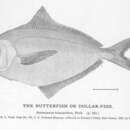Diagnostic Description
provided by Fishbase
This species is distinguished by the following characters: body oval to somewhat elongate, moderately deep (its depth 2.7 to 3 times in total length) and strongly compressed; eye medium-sized (its diameter 3.4 to 3.7 times in head length), surrounded by a small area of adipose tissue; snout short and blunt, lower jaw projecting somewhat beyond upper; mouth small, tip of maxillary not reaching to anterior eye margin; teeth in jaws very small, in a single row, while those in the upper jaw flattened and with 3 tiny cusps; dorsal and anal-fin bases very long (about equal in length), the anterior fin rays elevated, but fins not falcate, and both fins preceded by 3 short, weak, spines; caudal fin deeply forked; pectoral fins long (longer than head) and pointed; pelvic fins absent; a conspicuous series of 17 to 25 pores along anterior half of body under dorsal fin; lateral line high, following dorsal profile; scales small, present also on cheeks; caudal vertebrae 17 to 20; body color pale blue above, silvery below; numerous irregular dark spots on sides in live fish (fading after death) (Ref. 53006).
Diseases and Parasites
provided by Fishbase
Epitheliocystis. Bacterial diseases
Migration
provided by Fishbase
Oceanodromous. Migrating within oceans typically between spawning and different feeding areas, as tunas do. Migrations should be cyclical and predictable and cover more than 100 km.
Morphology
provided by Fishbase
Dorsal spines (total): 3; Analspines: 3
Trophic Strategy
provided by Fishbase
Forms large schools over the continental shelf, except during the winter months when it may descend to deeper water. Juveniles are generally found under floating weeds and jellyfish. Often found in brackish waters (Ref. 26938). Nerito-pelagic (Ref. 58426). Adults feeds mainly on jellyfish (Ref. 26938), squids, arrow worms, crustaceans and worms (Ref. 58426), also fish, benthic invertebrates and plankton (Ref. 2702). Preyed upon by haddock, silver hake, bluefish, weakfish and swordfish, Xiphias gladius. Parasite found was a monogenean, Microcotyle poronoti (Ref. 5951).
Biology
provided by Fishbase
Forms large schools over the continental shelf, except during the winter months when it may descend to deeper water. Juveniles are generally found under floating weeds and jellyfish. Often found in brackish waters (Ref. 26938). Nerito-pelagic (Ref. 58426). Adults feeds mainly on jellyfish (Ref. 26938), squids, arrow worms, crustaceans and worms (Ref. 58426). Marketed fresh, smoked and frozen; eaten fried, broiled and baked (Ref. 9988). Mostly frozen and exported to Japan.
Importance
provided by Fishbase
fisheries: commercial; gamefish: yes
American butterfish
provided by wikipedia EN
The American butterfish (Peprilus triacanthus), also known as the Atlantic butterfish, is a butterfish of the family Stromateidae.[2]
Description
Fish of this species are usually deep-bodied, flattened sideways, and somewhat circular or rounded, with blunt noses and small mouths with weak teeth. Some other characteristics of this fish are the absence of ventral fins, one long, continuous dorsal fin, long pectoral fins, and tiny, cycloid scales. The tail fin is nearly as long as the dorsal fin and deeply forked. The American butterfish is similar in appearance to its close relative, the harvestfish (Peprilus alepidotus), but can be distinguished by its much lower dorsal and tail fin.
This fish is a lead-blue color above with pale sides and a silvery belly. It often has dark, irregular spots.
It is generally 6–9 in (15–23 cm), though some individuals reach 12 in (30 cm). They can weigh from 1.75–20 ounces (50–567 g).
Distribution and habitat
The American butterfish ranges from the Atlantic coast of North America, from the offing of South Carolina and from coastal North Carolina waters to the outer coast of Nova Scotia and Cape Breton; northward as a stray to the Gulf of St. Lawrence, to the south and east coasts of Newfoundland; and southward to Florida in deep water.[3] Relatively little is known about the American butterfish considering it is an important food source and a common species. It travels in small bands or loosely organized schools, preferring sandy-bottomed areas to muddy ones, and often coming close to shore. During summer months, it does not swim deeper than 10 to 15 fathoms (20 to 30 m), but in the winter and early spring, it may be found 100 to 115 fathoms (200 to 230 m) below the surface.
Feeding
It feeds on small fish, crustaceans, and annelids.
Breeding
The American butterfish spawns in the Gulf of Maine during the summer months, peaking in July. It appears to spawn a few miles out to sea and returns to the coast when finished. Incubation lasts less than 48 hours in water at 65 °F (18 °C). Fry are 2 mm (0.079 in) long at hatching, and by autumn, have grown to a length of 3–4 in (7.6–10.2 cm). They appear to reach maturity at about two years of age.
References

- license
- cc-by-sa-3.0
- copyright
- Wikipedia authors and editors
American butterfish: Brief Summary
provided by wikipedia EN
The American butterfish (Peprilus triacanthus), also known as the Atlantic butterfish, is a butterfish of the family Stromateidae.
- license
- cc-by-sa-3.0
- copyright
- Wikipedia authors and editors
Diet
provided by World Register of Marine Species
Feeds on small fishes, squids, amphipods, shrimps and marine worms
North-West Atlantic Ocean species (NWARMS)
- license
- cc-by-4.0
- copyright
- WoRMS Editorial Board
Distribution
provided by World Register of Marine Species
Eastern Newfoundland to Gulf of Mexico
North-West Atlantic Ocean species (NWARMS)
- license
- cc-by-4.0
- copyright
- WoRMS Editorial Board
Habitat
provided by World Register of Marine Species
nektonic
North-West Atlantic Ocean species (NWARMS)
- license
- cc-by-4.0
- copyright
- WoRMS Editorial Board
Habitat
provided by World Register of Marine Species
Found over the continental slope to depths of 15 m, may descend deeper in winter.
North-West Atlantic Ocean species (NWARMS)
- license
- cc-by-4.0
- copyright
- WoRMS Editorial Board

